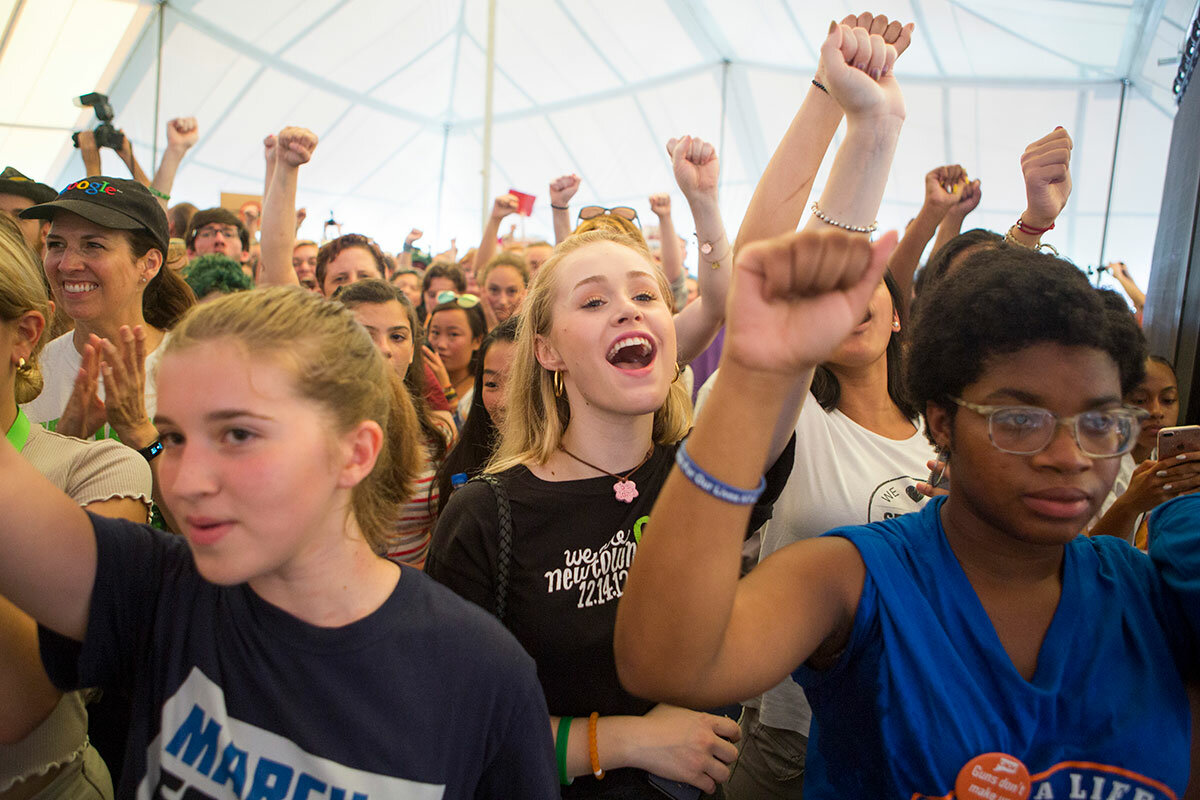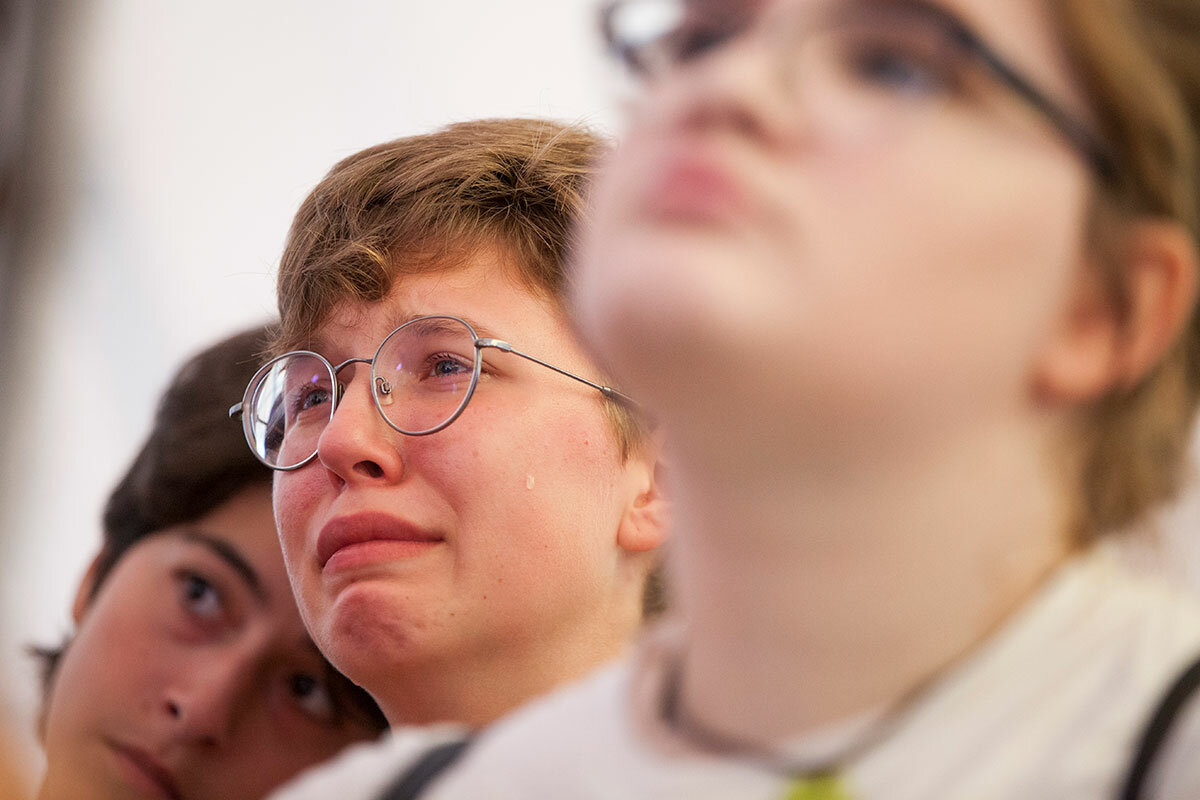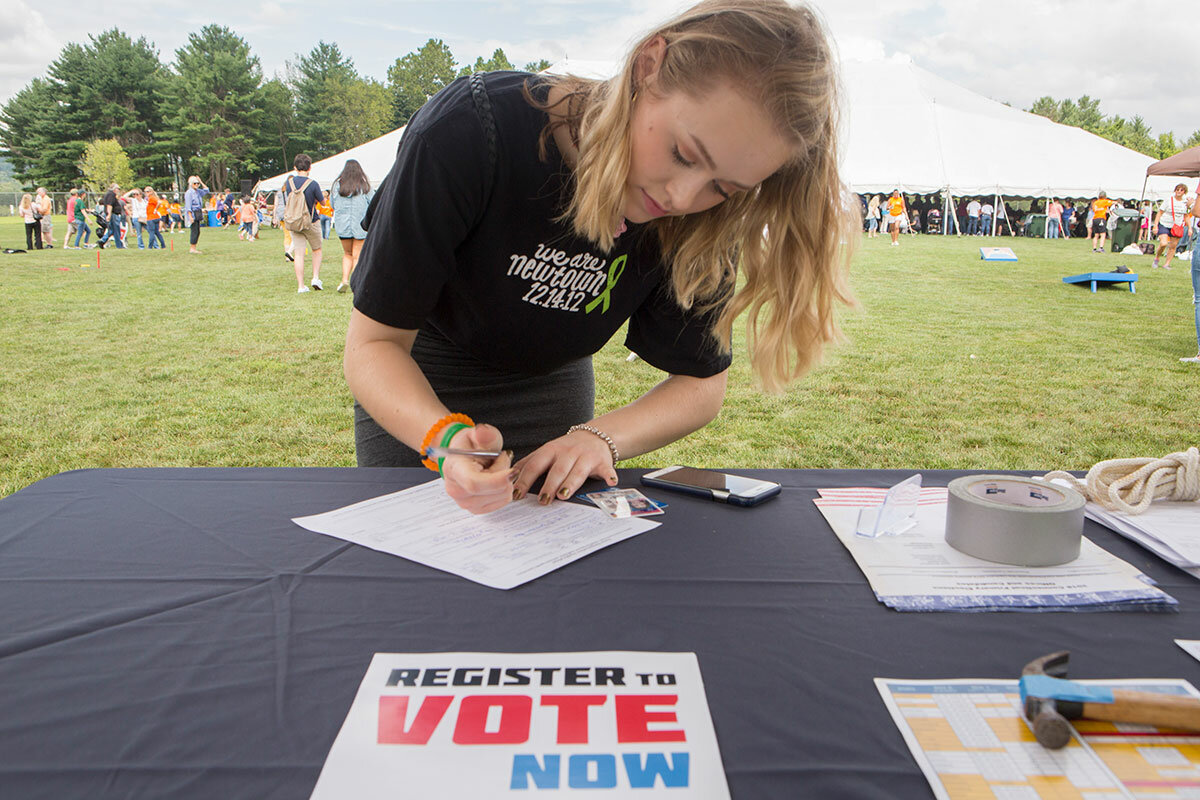Teen activists' power play: Unite on gun control, then get out the vote
Loading...
| Newtown, Conn.
From a distance it almost looked like a summer fair. Food trucks served nachos and ice cream, young families played corn hole, and a local band played music over a loudspeaker.
But a booth in the center of the field labeled “Voter Registration,” with its volunteers in neon yellow shirts, hinted that the event was something else.
Student activists from Marjory Stoneman Douglas High School in Parkland, Fla., wrapped up their summer-long March for Our Lives: Road to Change national tour in Newtown, Conn., on Sunday after visiting more than 20 states across the United States.
Why We Wrote This
Student activism is growing, but it's not happening in a vacuum. Young people say that to make lasting changes, they have to speak with a united voice.
The tour began in early June in Chicago, where 174 people under the age of 17 have been shot and killed since September 2011, before ending in Newtown, where 20 first graders and six educators were shot and killed at Sandy Hook Elementary School in 2012. The two cities are intentional bookends for a tour aimed at registering and motivating young Americans to vote.
Despite having different connections to gun violence, young people from these three cities say they are doing what has never been done before: creating a unified front against the National Rifle Association (NRA).
“I think that when there's 50 different people saying 50 different messages, it's so confusing to choose one that we think is most important,” says Jackson Mittleman, a rising senior at Newtown High who lost a friend in the Sandy Hook shooting and is now co-chair of the Jr. Newtown Action Alliance. “But if we all start talking about background checks at same time, the country is going to pay attention to background checks.”
After 17 people died in the Marjory Stoneman Douglas school shooting on February 14, gun control supporters – including activists like Jackson with their own pre-established groups – rallied behind the Parkland students. They witnessed newfound attention from the American public and media because for the first time the victims were the spokespeople, rather than parents or community members, says Saul Cornell, a legal historian at Fordham University in New York who focuses on gun control and attended the rally on Sunday.
“If you’re pro-gun, you have the NRA, gun ranges, gun stores.... If you are a small, organized group you will beat a larger more diffuse group,” says Dr. Cornell. “There’s no question the needle has shifted because of these kids. You can see the changes.”
A spike in voter registration
Voter registration has increased among 18 to 29 year olds in at least 35 states since the Parkland shooting, the political data firm TargetSmart found in a July analysis. Politically competitive states saw the greatest increases, with young voter registration growing by more than 16 percent in Pennsylvania, more than 11 percent in Virginia, and almost 8 percent in Florida. Jackson tells a cheering crowd in Newtown that voter registration in Connecticut has gone up 200 percent since the last election.
“Parkland students have used this issue to have a greater conversation about the importance of politics among young people in a way that very few people have in recent time,” says John Della Volpe, director of Harvard University’s Institute of Politics, whose work focuses on Americans between the ages of 18 and 29. “They have transcended politics, they have transcended culture.”
Still, there is an underlying bitterness in Chicago and Newtown – not at the Parkland teens specifically, but at a country that just now started listening. To some teenagers in Chicago, the issue feels race-based: gun violence has always been a part of their lives, but it took a shooting in a wealthy, white suburb to call attention to young gun deaths. The demographics in Newtown are relatively similar to Parkland, making the frustration more diffuse.
“Why was Sandy Hook not enough?” says Momo Burns-Min, a rising junior in Weston, Conn., as her eyes scan the hundreds of people swarming the event’s humid tent. She was in fifth grade when the Sandy Hook shooting happened and she remembers having to color snowmen for four hours while her school was in lockdown.
“I’m so honored to be in the generation of these Parkland kids,” says Momo, “but at the same time, why’d it take this long?”
Still, they see themselves as teammates, and natural friendships have formed between the Newtown and Parkland teens. In an area behind the tent reserved for Newtown and Parkland families, students in dark blue “March for Our Lives” shirts and orange “Sandy Hook Promise” shirts laugh, hug, and take selfies.
“Something that really surprised me was how much these kids are like us,” says Isabella Wakeman, a board member for the Jr. Newtown Action Alliance. “[T]hey're not this big star on a pedestal… That was really surprising for me to see that we can actually make a really personal bond, and not just a bond as an activist.”
At the event, two teenage boys tell Cameron Kasky, an outspoken student from Parkland, their own story. “We go to a conservative Catholic school and they were not supportive of a walk-out, but we did it,” says one of the boys, a look of pride on his face.
Parkland students David Hogg and Emma González arrive shortly before the speakers begin. “Our eyes started watering when we saw her,” says Jessie Braden, a rising junior from Weston, Conn., referring to Ms. González. The audience claps and cheers when the teens enter.
Cameron, Emma, and David look tired. They have just come from a closed door meeting with the families of Sandy Hook victims and they are wrapping up a nationwide tour with almost daily events, where students come to them for encouragement – to share the weight of their own history with gun violence.
“Both Parkland and Newtown are two ordinary, isolated towns that never have had to cross paths,” says Jaclyn Corin, a rising senior at Marjory Stoneman Douglas and March for Our Lives organizer. “We were brought together, however, not only because we have experienced the same deplorable pain, but also because of the same monumental strength that arose from the victims and survivors in the aftermath of both tragedies.”
A promise for further involvement
When it is time for Jackson and co-chair Tommy Murray to speak to the crowd, Tommy asks the audience members to raise their right hand and promise to vote to end gun violence. It’s difficult to find someone in the audience not raising their hand.
And there is reason to believe they are telling the truth. Young Americans are more likely to vote when they believe their political involvement will actually have an impact, says Mr. Della Volpe, and since the 2016 election, more young Americans agree that their political involvement has tangible results – a reversal of an apathetic trend that began around 2013, after the economic recession and years of political gridlock.
“We see the relevancy of politics changing in the eyes of young people,” says Della Volpe. “There haven't been a lot of ‘wins’ recently when it comes to [gun reform].... But the Parkland students have had successes so far. You can see the tangible successes.”
On March 9, less than one month after the shooting at Marjory Stoneman Douglas, Florida Gov. Rick Scott signed new legislation that raises the state’s minimum age to buy shotguns and rifles from 18 to 21 and bans bump stocks. The Parkland students and other young activists at the rally say they will continue their get-out-the-vote efforts this fall ahead of the 2018 midterm elections to support candidates who favor gun control.
An April poll by Harvard’s Institute of Politics (IOP) found that 64 percent of Americans between the ages of 18 and 29 believe the country’s gun control laws should be more strict – a 15-point increase from a 2013 IOP poll after the school shooting in Newtown. The most interesting part of this increase, says Della Volpe, is that it has occurred across the political spectrum, among both young Democrats and young Republicans.
At the voter registration booth in the center of the rally, a young woman hands her clipboard to a volunteer, who offers to check over her registration form and congratulates her on this coming-of-age event.
“I was going to register anyway but it was pretty cool to do it here with the community,” says Hope Hottois, who turned 18 in March. Coming to the rally today was so important to Ms. Hottois that she drove to Newtown alone from her home in Monroe, Conn.
“When Sandy Hook happened here I was only 12. It was hard to process what was going on,” says Hottois. “But now I’m 18. I’m coming into my own and I’m finding my own voice.”
Correction: This story has been updated to correct the first name of Momo Burns-Min.









